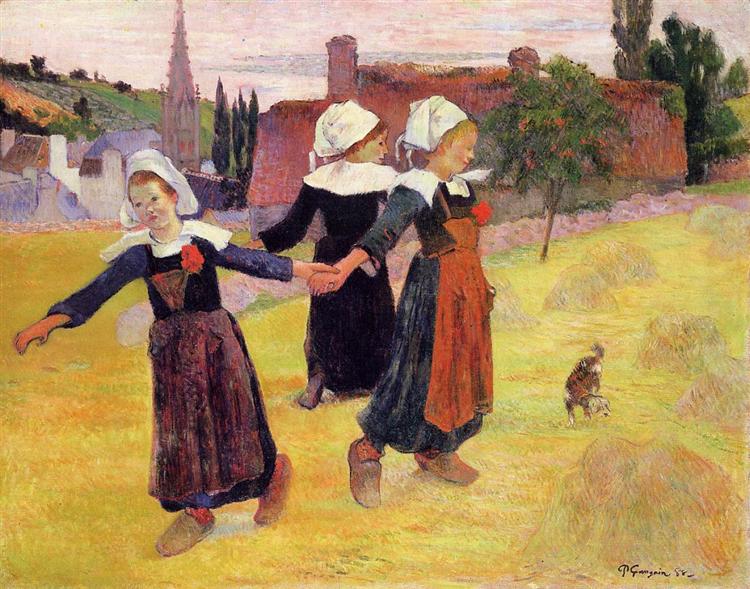Description
Paul Gauguin's "Breton Girls Dancing" (1888) is a fascinating depiction of the folklore and culture of French Brittany, captured through the eyes of one of the most influential post-impressionists of the 19th century. Evidently a landmark in Gauguin's career, this painting stands as a sublime example of his use of color and composition in his quest for a reality that transcended mere naturalism.
In the work, two young women, dressed in traditional Breton costumes, are the very essence of celebration and connection with the land around them. The way the figures are arranged on the canvas is central to the composition. The girls are arranged in a kind of circle, an element that evokes the idea of unity and community, while their posture suggests rhythmic movement, as if they were caught in the inertia of a festive dance. This dynamic aspect contributes to the sense of life in the work, almost palpable to the viewer.
The color palette selected by Gauguin is rich and symbolic, an aspect that separates him from his contemporaries. Through vibrant shades of green, yellow, and blue, the artist not only describes the nature of Brittany but also invokes an emotional sense, creating a vibrant space that seems to vibrate with energy. The colors are flat and the shapes stylized, elements that conventionally align with Gauguin’s signature symbolism. His approach to color and form also bears testimony to his fervent search for a visual language beyond the imitation and denunciation of academic art.
The women’s faces, though partly hidden by the shadow cast by their hats, are filled with the pure essence of youth and joy; an echo of the spirit of rural life in 19th-century Brittany. Through his gaze and his presence, Gauguin seems to explore not only regional identity but also the female condition in a social landscape that was in transition. This approach to youth and local culture can also be found in his other works, where the lives of women in various cultures become the fulcrum of his artistic exploration.
The work was painted in the context of a period when Gauguin deliberately distanced himself from Impressionist techniques. His move to Brittany was an attempt to escape the urban influences of Paris and seek a more authentic connection with nature and the simplicity of country life. In this sense, "Breton Girls Dancing" can be considered a statement of artistic principles, a formalization of his desire to connect the primitive with the modern.
Above all, the work reflects Gauguin's attempt to capture an emotional and lived experience that goes beyond literal representation. As in other works such as Where Do We Come From? Who Are We? Where Are We Going?, Gauguin delves into the search for an art that represents not just a culture, but the search for truth in the human condition. Breton Girls Dancing is a brilliant evocation of these concepts, presenting a celebration not just of a place and a time, but of how deeply interconnected art can be with the human experience.
KUADROS ©, a famous painting on your wall.
Hand-made oil painting reproductions, with the quality of professional artists and the distinctive seal of KUADROS ©.
Painting reproduction service with satisfaction guarantee. If you are not completely satisfied with the replica of your painting, we will refund 100% of your money.

